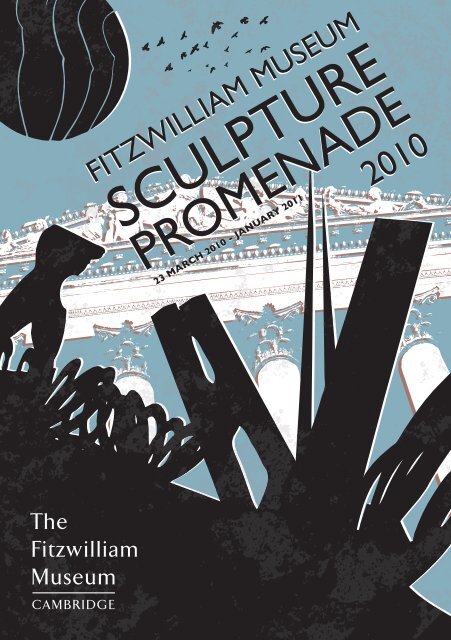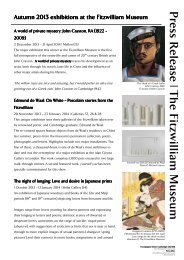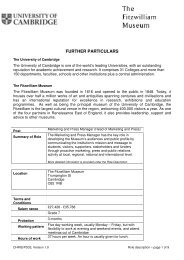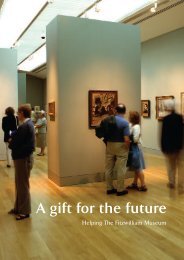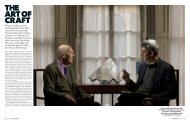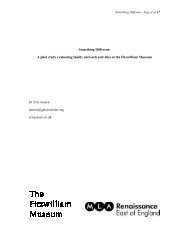Download PDF format - The Fitzwilliam Museum
Download PDF format - The Fitzwilliam Museum
Download PDF format - The Fitzwilliam Museum
Create successful ePaper yourself
Turn your PDF publications into a flip-book with our unique Google optimized e-Paper software.
23 23 MARCH 2010 2010 - - JANUARY JANUARY 2011 2011
he <strong>Fitzwilliam</strong> <strong>Museum</strong> Sculpture<br />
Promenade, established in<br />
2009, provides a showcase for<br />
contemporary and modern sculpture on<br />
the lawns of <strong>The</strong> <strong>Fitzwilliam</strong> <strong>Museum</strong>.<br />
Free to all and accessible from the main<br />
thoroughfare of central Cambridge, the<br />
works are displayed for ten months. This<br />
year’s installation has been selected and<br />
organised by the <strong>Museum</strong>’s Director<br />
Timothy Potts and Cambridge sculptor<br />
Helaine Blumenfeld, past Vice-President<br />
of the Royal British Society of Sculptors<br />
(RBS). <strong>The</strong> fourteen works by six<br />
sculptors were selected from submissions<br />
by members of the RBS, and will be on<br />
display until January 2011.<br />
<strong>The</strong> works are illustrated and described in<br />
this brochure based on texts supplied by<br />
the artists.<br />
<strong>The</strong> expansive lawns and historic façade of<br />
the <strong>Museum</strong> provide a striking backdrop<br />
for the display of contemporary art, which<br />
these installations seek to exploit.<br />
<strong>The</strong> works have been designed for<br />
outdoor display, where they interact<br />
physically and aesthetically with their<br />
landscape and with visitors. Some are<br />
conceived and fashioned in ways that<br />
respond to changes in light, weather and<br />
the seasons; here the effects of exposure<br />
to the elements are welcomed as part<br />
of the works’ dynamic and evolving<br />
character. Visitors are invited to walk<br />
amongst the sculptures and interact with<br />
them. Touching is permitted - unlike<br />
inside the <strong>Museum</strong> - although climbing<br />
and any other activity that could cause<br />
personal injury or damage to the works<br />
are not. Comments on the Promenade,<br />
through the <strong>Museum</strong>’s website, are<br />
welcome!<br />
Dr Timothy Potts<br />
Director
ROB WARD<br />
Two<br />
Stainless steel<br />
1 2 3<br />
Screen<br />
Stainless steel<br />
Rob Ward lives and works in Hebden<br />
Bridge, West Yorkshire. His work<br />
has been commissioned worldwide,<br />
and exhibited internationally. Ward’s<br />
exhibitions include Scultura Internationale<br />
in Italy, 20th Century British Sculpture at<br />
the Guggenheim <strong>Museum</strong> in Venice, a<br />
retrospective exhibition at <strong>The</strong> Henry<br />
Moore Study Centre and a major show<br />
at the Shanghai Sculpture Park in China.<br />
Educated at Newcastle University and<br />
Reading University, the artist also gained<br />
scholarships to Greece and Italy.<br />
Ward’s work is an ongoing dialogue<br />
between drawing and sculpture,<br />
exploring the spaces between two<br />
and three dimensions - the actual and<br />
metaphysical spaces which create spatial<br />
tension. His sculpture incorporates<br />
the viewer into a relationship which<br />
is, says Ward, “meditative, reflective<br />
and mindful of the sanctity of place”.<br />
<strong>The</strong> works exhibited at the Sculpture<br />
Promenade are part of a series exploring<br />
Buttress<br />
Stainless steel<br />
architectural form in a sculptural context.<br />
<strong>The</strong>se three works are constructed in<br />
mirror-polished stainless steel to allow<br />
them to reflect their surroundings, as<br />
well as their place and relationship to the<br />
viewer.<br />
Each work deals with a different<br />
sculptural idea, with regard to scale,<br />
movement and drawing, and is conceived<br />
as a form which allows drawing to<br />
happen on its surface, “activating<br />
the passing of time”. Two articulates<br />
itself through a series of cuts in space,<br />
inverting itself to offer a double take<br />
on the idea of reflection. Screen, by<br />
contrast, is designed to be walked along,<br />
diminishing in size, with the end element<br />
reflecting and doubling the lower part of<br />
the sculpture. Buttress is a robust, offset<br />
symmetrical form, describing a familiar<br />
shape in a new aspect.<br />
ANGELA CONNER<br />
Wave<br />
Carbon resin &<br />
stainless steel<br />
4 5 6<br />
Poise<br />
Stainless steel & resin with<br />
marble dust<br />
Angela Conner’s sculptures harness<br />
the forces of our environment - water,<br />
wind, gravity and sun. <strong>The</strong>se natural<br />
elements move and unfold the forms in<br />
her work, which ranges from immense<br />
landscape sculptures to small intimate<br />
pieces. She has made both indoor and<br />
outdoor mobiles thought to be the tallest<br />
in the world. Conner is represented in<br />
many public and private collections, and<br />
in major museums both nationally and<br />
internationally. She has been awarded<br />
the Institute of American Architects<br />
Honour Award for sculpture and codesign<br />
of the Heinz Plaza, Pittsburgh<br />
USA, and her 129 ft sculpture Wave<br />
in Ireland was given the Business to<br />
Arts Award. She won the Kinetic Art<br />
International Organisation’s first prize,<br />
amongst others.<br />
Conner’s original interest in natural<br />
elements stems from her nomadic<br />
childhood. One of this period’s few<br />
constants was a stream at the bottom<br />
of the garden of a Dorset holiday home,<br />
and Conner frequently played with water<br />
and the effect of wind on objects she<br />
made. “All children play with simple<br />
Sway II<br />
Stainless steel & resin with<br />
metal finish<br />
things - twigs, cardboard, mud - then<br />
they stop as young teenagers, wanting<br />
man-made things,” says Conner. “I just<br />
carried on.” As an adult after sculpting<br />
in the United States, she returned to<br />
England where she worked for Barbara<br />
Hepworth. Encouraged by this, she set<br />
up her studio in London and has been<br />
based there since.<br />
Conner is crucially aware of the pressures<br />
of the modern world, and creates<br />
tranquil images as a counterbalance.<br />
In a literal sense, this understanding of<br />
balance is a theme in all her work.<br />
<strong>The</strong> six elements that make up Poise<br />
sway slowly in the wind, with their<br />
shapes causing patches of light to play<br />
and change over the surfaces of the<br />
sculpture. Sway II is developed from<br />
the shapes explored in Poise, with the<br />
elements further refined and elongated<br />
to produce a dominant piece. Wave,<br />
the tallest of the three, is inspired by<br />
Conner’s fascination with the energy of<br />
the Turkish calligraphy she encountered<br />
while exhibiting at the Istanbul Biennale.<br />
Moved by the breeze, the pointed top<br />
scribes a line in the sky.
NICK TURVEY<br />
Chief<br />
Corten steel & enamel paint<br />
Nick Turvey’s approach to sculpture is<br />
influenced by his training as an architect,<br />
followed by fifteen years making films.<br />
He returned to study sculpture at the<br />
Royal College of Art, graduating with<br />
an MA in 2006, and lives and works<br />
in London. In the last few years he<br />
has completed several large public<br />
commissions, as well as residencies in<br />
Venice and Delhi.<br />
Turvey’s interest lies in forms that are<br />
elemental, but intermediate between<br />
recognisable objects - “in this way”, says<br />
Turvey, “one could make connections<br />
with the work of Tony Cragg, Olafur<br />
Eliasson and Anish Kapoor, yet equally<br />
important to me are composers such as<br />
Ligeti and Xenakis, similarly fascinated<br />
by the lyrical potential of mathematics.”<br />
Turvey also cites as influences the<br />
“darker, absurdist visions” of Samuel<br />
Beckett, David Lynch and Hieronymus<br />
Bosch - even the “graphic brilliance” of<br />
cartoons such as Ren and Stimpy.<br />
In recent work, Turvey has been<br />
developing “a new kind of realism, using<br />
abstraction to trigger responses at a<br />
7<br />
Venus<br />
Moulded fibreglass<br />
8<br />
neural level”. Venus and Chief are taken<br />
from his current ‘Incarnate’ series, in<br />
which a simple, rhythmic form is the<br />
starting point for various trans<strong>format</strong>ions,<br />
much like a set of musical variations.<br />
Each piece exploits the associations of a<br />
specific material, examining the human<br />
body as a physical object, and the role<br />
it plays in myth, propaganda, dream<br />
and fetish. Describing Chief as “skeletal,<br />
lacerated, wetly red and rusty,” Turvey<br />
says that the work “reeks with the pathos<br />
of toppled dictators, heroic warriors; the<br />
body as a totem, a weapon.” Of Venus,<br />
the artist comments that “classically,<br />
the goddess of love was paired with the<br />
god of war, but this Venus - soft, bulging,<br />
enveloping - provokes both lust and<br />
disgust, putting us into an uncomfortably<br />
child-like viewpoint.” “<strong>The</strong>se primal<br />
reactions”, says Turvey, “reveal the<br />
overwhelming nature of our desire to see<br />
ourselves reflected in the world around<br />
us”.<br />
Nick Turvey gratefully acknowledges<br />
support from Benson-Sedgwick Engineering<br />
Ltd. and Hammerite Worldwide.<br />
ANN CHRISTOPHER<br />
9<br />
Beyond Silence<br />
Bronze<br />
Line of Silence<br />
Bronze<br />
Ann Christopher studied sculpture at<br />
Harrow School of Art and the West of<br />
England College of Art between 1965<br />
and 1969. On leaving college she set up a<br />
studio, initially earning a living by working<br />
technically for other sculptors and<br />
working in a fine art foundry. Producing<br />
and exhibiting her own work from the<br />
very beginning, this technical skill and<br />
knowledge is used to the full in her work.<br />
She was elected to the Royal Academy in<br />
1980 and as a fellow of the RBS in 1992.<br />
She lives and works near Bath.<br />
Christopher’s non-figurative sculpture,<br />
usually in cast metal, ranges in size from<br />
20 to 600 cm, with many of the larger<br />
works being commissioned for public<br />
and private spaces in the UK, Europe and<br />
the USA. On the origins and inspiration<br />
for her work Christopher says: “<strong>The</strong><br />
origins of an idea can only be sought and<br />
sometimes discovered in retrospect.<br />
I am aware that I become obsessed<br />
with certain visual experiences - specific<br />
10 11<br />
Held Shadow<br />
Corten steel<br />
shapes or lines, and know that they<br />
will feed into my work at some<br />
point in the future. In fact, every<br />
part of my life fuels the store for a<br />
future sculpture.”<br />
Rock <strong>format</strong>ions and cut lines were<br />
a strong influence on the three<br />
works in the Sculpture Promenade.<br />
<strong>The</strong> titles also provide clues, with<br />
Line of Silence and Beyond Silence<br />
referring to the silent powerful<br />
presence a sculpture should have;<br />
“the power of standing stones”.<br />
Held Shadow is a more descriptive<br />
title, but “alludes to the ephemeral<br />
quality of the shadows now<br />
becoming an obsession”. “<strong>The</strong>se<br />
sculptures”, says Christopher,<br />
“are about solitude and presence,<br />
and demand contemplation; not<br />
searching for the familiar or known,<br />
but allowing time for this interconnection.”
NICK HORNBY<br />
12<br />
I never wanted to weigh more heavily on a man than a bird (Coco Chanel)<br />
Resin, glass fibre, paint<br />
Nick Hornby is an emerging British<br />
sculptor, described by ES magazine as<br />
“a new Gormley” and featured in the<br />
Evening Standard’s “Who to Watch in<br />
2010” list. In January he was shortlisted<br />
for the inaugural £45,000 Spitalfields<br />
Sculpture Prize. Recent works in 2009<br />
include Walking in Our Mind at the<br />
South Bank Centre, and <strong>The</strong> Ghost in the<br />
Machine at Tate Britain. He has been<br />
awarded the Clifford Chance Sculpture<br />
Prize, the Deidre Hubbard Sculpture<br />
Award and shortlisted by Cornelia Parker<br />
for the Mark Tanner Sculpture Prize.<br />
This sculpture comes from a body<br />
of work that concerns the origin of<br />
ideas and how artworks are read and<br />
interpreted. Of his inspirations, Hornby<br />
says: “Where does an idea come from? Is<br />
it always the sum of many other ideas? Is<br />
it always borrowed or stolen? Rodin<br />
didn’t invent thinking, or Van Gogh<br />
sunflowers. If artworks are always the<br />
product of sources and inspiration, is<br />
an artwork always divisible to the<br />
sum of its parts, or can it become<br />
so cooked that you lose sight of its<br />
origin?”<br />
For the 2010 Sculpture Promenade,<br />
Hornby created a sculpture from<br />
the projected imaginary space<br />
that exists between three other<br />
sculptures: Hepworth’s Form III,<br />
Rodin’s Walking Man, and Brancusi’s<br />
Bird in Space. <strong>The</strong> sculptures are<br />
distributed around 360º so that<br />
each has equal influence over the<br />
final object. Hornby’s work, with its<br />
“tricky, liminal personality”, reveals<br />
its sources and gives the viewer<br />
a puzzle asking questions about<br />
authorship and autonomy.<br />
“According to Lévi-Strauss,” says<br />
Hornby, “the trickster is almost<br />
always a raven or a coyote. In this<br />
case it is a form, a man and a bird.”<br />
MICHAEL LYONS<br />
Unity of Opposites: Vortex<br />
Copper<br />
Michael Lyons studied at the Hornsey<br />
College of Art and the University of<br />
Newcastle, and was formerly Head of<br />
Sculpture at Manchester Metropolitan<br />
University. A founding Member of<br />
the Yorkshire Sculpture Park in 1997<br />
and Vice President of the Royal British<br />
Society of Sculptors from 1994 to 1997,<br />
Lyons has taken up artistic residencies at<br />
institutions in Beijing and Shanghai, and has<br />
represented Britain in sculpture symposia<br />
and biennales around the world. In 2003<br />
he won the Yuzi Prize (1st Prize) at the 1st<br />
Guilin Yuzi Paradise International Sculpture<br />
Awards and the Premio Fondo Nacional<br />
de las Artes at Chaco Biennale, Resistencia,<br />
Argentina in 2006.<br />
Lyons lives and works in Cawood,<br />
Yorkshire, but has worked and travelled<br />
extensively abroad, with travels to China<br />
and Mexico in particular having a profound<br />
effect on his life and ideas. His upbringing<br />
in the heart of the Industrial Midlands<br />
heavily informed his early constructed<br />
steel sculpture, although this mechanical<br />
sensibility has now given way to more<br />
organic forms, and working with plaster<br />
and clay allows Lyons to imbue his<br />
works with a new fluidity. In whatever<br />
medium, Lyons’ sculpture is dynamic and<br />
13 14<br />
Energy of the Mountain:<br />
Echo and Revelation<br />
Copper<br />
monumental; it relies on a formal<br />
strength informed by poetic allusion<br />
and layers of meaning. His work<br />
draws upon mythology, the forces<br />
of nature and primitive cultures,<br />
often relating directly to the places in<br />
which he travels.<br />
<strong>The</strong> two works on display, Unity of<br />
Opposites: Vortex and Energy of the<br />
Mountain: Echo and Revelation, have<br />
been described as exploring the<br />
tensions that exist within modern<br />
society between materialistic<br />
cravings and spiritual needs. Chinese<br />
sculptor and art historian Professor<br />
Li Xiu Qin compares Lyons’ work to<br />
the teachings of ancient philosopher<br />
Zhuang Zi: that the journey towards<br />
self-knowledge is the ultimate goal<br />
of human existence, and selfdestruction<br />
is the result of seeking<br />
fame, wealth and power at the<br />
expense of this spiritual pursuit.<br />
“<strong>The</strong>se two works”, says Li, “express<br />
the way in which human beings exist<br />
in a whirlpool of spirit and matter,<br />
with movement both forward<br />
and backward. From within these<br />
contradictions comes the search for<br />
balance, order and harmony.”
GROUND PLAN<br />
COURTYARD<br />
ENTRANCE<br />
ROB WARD<br />
1<br />
2<br />
3<br />
4<br />
5<br />
6<br />
1<br />
Two<br />
Stainless steel<br />
Screen<br />
Stainless steel<br />
Buttress<br />
Stainless steel<br />
2<br />
Wave<br />
Carbon resin & stainless steel<br />
3<br />
4<br />
5<br />
7<br />
TRUMPINGTON STREET<br />
Poise<br />
Stainless steel & resin with marble dust<br />
Sway II<br />
Stainless steel & resin with metal finish<br />
NICK TURVEY<br />
7<br />
8<br />
Venus<br />
Moulded fibreglass<br />
Chief<br />
Corten steel & enamel paint<br />
6<br />
8<br />
FOUNDER’S<br />
BUILDING<br />
12<br />
9<br />
14<br />
13<br />
MAIN<br />
ENTRANCE NORTH<br />
LAWN<br />
CAFÉ<br />
ANN CHRISTOPHER<br />
9<br />
10<br />
11<br />
12<br />
Beyond Silence<br />
Bronze<br />
Line of Silence<br />
Bronze<br />
Held Shadow<br />
Corten steel<br />
ANGELA CONNER NICK HORNBY<br />
13<br />
14<br />
I never wanted to weigh more<br />
heavily on a man than a bird<br />
(Coco Chanel)<br />
Resin, glass fibre, paint<br />
MICHAEL LYONS<br />
Unity of Opposites: Vortex<br />
Copper<br />
Energy of the Mountain:<br />
Echo and Revelation<br />
Copper<br />
10<br />
11<br />
Cover and introduction images © <strong>The</strong> <strong>Fitzwilliam</strong> <strong>Museum</strong><br />
Rob Ward<br />
Sculpture photography © Rob Ward<br />
Artist image © Rob Ward<br />
Angela Conner<br />
Sculpture photography © Angela Conner<br />
Artist image © Nat Rea<br />
Nick Turvey<br />
Sculpture photography © Nick Turvey<br />
Artist image © Oliver Curtis<br />
Ann Christopher<br />
Sculpture photography © Ann Christopher<br />
Artist image © Steve Russell<br />
Nick Hornby<br />
Sculpture photography © Nick Hornby<br />
Artist image © Sam Pelly<br />
Michael Lyons<br />
Energy of the Mountain: Echo and Revelation © University of Bolton<br />
Unity of Opposites: Vortex © Mike Lyons<br />
Artist image © University of Bolton
Trumpington Street<br />
Cambridge CB2 1RB<br />
www.fitzmuseum.cam.ac.uk


